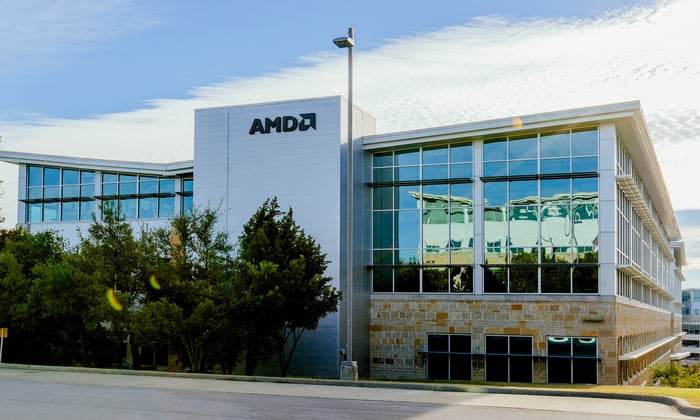These tech companies are benefiting from growing investment in AI chips and software.
Artificial intelligence (AI) represents a major opportunity for businesses across industries to develop products faster and cheaper than ever before. The race to gain a data-driven edge on the competition is fueling massive investment across the entire tech supply chain from data centers to software.
Many of the key players enabling this new industrial revolution are already valued at over $1 trillion market caps. But as governments and businesses continue to invest in this technology, there are two AI enablers that are still valued under $500 billion that could be worth buying today. Here’s why growing competition in AI could propel these companies into the trillion-dollar club.
1. Palantir Technologies
Palantir (PLTR 0.11%) started as a government contractor, providing AI-powered software for intelligence and counterterrorism efforts. But now its software is experiencing insatiable demand in the private sector. Companies are seeing significant cost savings, which means Palantir can benefit from companies scrambling to adopt AI solutions to remain competitive.
If one company in an industry uses Palantir to gain operating efficiencies, it creates a competitive advantage. This pushes more businesses to consider investing in Palantir’s platforms or risk falling behind. This can explain in part why Palantir’s U.S. commercial revenue has exploded this year, nearly doubling year over year in the second quarter.
Palantir closed its highest quarter yet of total contract-value bookings of $2.3 billion, representing a year-over-year increase of 140%. It is signing bigger deals while also seeing existing customers continue to spend more, leading to a healthy 128% net-dollar retention rate.
Palantir is effectively a tool that improves a company’s profits. Its software is expensive relative to alternative software vendors, but Palantir still expects accelerating growth next quarter. This signals it has a competitive edge. Palantir’s ontology-based system creates a digital twin of a company’s operations, helping managers make sense of unorganized data for better decision making.
Importantly, Palantir is converting revenue into very high margins that are driving robust growth in earnings and free cash flow. This is one reason why the stock has performed so well and may continue to outperform Wall Street’s expectations.
For what it’s worth, widely followed tech analyst Dan Ives at Wedbush Securities sees Palantir stock hitting a market cap of $1 trillion in the next three years. Keep in mind, the stock trades at an expensive valuation, so market sentiment will play a role in how the stock performs in the near term. Given the potential for volatility in the share price, investors should plan on holding it for at least 10 years. Long term, the savings and efficiencies Palantir brings to other companies could make it one of the most valuable companies in the world.

Image source: Advanced Micro Devices.
2. Advanced Micro Devices
The companies providing the chips for AI continue to benefit from increasing competition among the leading model builders. OpenAI just announced a deal to deploy six gigawatts of chips, which amounts to hundreds of thousands, from Advanced Micro Devices (AMD -0.52%) over the next several years.
OpenAI’s ChatGPT is the most popular AI model with over 700 million weekly active users. But to meet growing demand, it has to expand its compute capacity to compete with rivals, including xAI’s Grok and Google Gemini, which also continue to invest in more infrastructure. This growing competition will benefit AMD.
OpenAI’s deal with AMD validates the capabilities of its upcoming pipeline of graphics processing units (GPUs). AMD’s data center business has not been growing as fast as Nvidia‘s, but it is expected to accelerate over the next year, and the deal with OpenAI is a catalyst.
While Nvidia’s GPUs have been widely used by data centers for powering large AI training loads, AMD’s chips have an advantage in handling small-to-medium-sized AI tasks. This is by design. AMD’s Instinct family of GPUs feature a high amount of memory bandwidth that makes them well suited for the AI inference market, which CEO Lisa Su believes is going to be much bigger than AI training.
OpenAI will deploy the first gigawatt of AMD Instinct MI450 GPUs in the second half of 2026. Analysts currently expect AMD’s revenue to grow 28% in 2025 before increasing by 26% in 2026, according to Yahoo! Finance. Earnings should grow even faster due to the high margins of data center GPUs.
The stock currently has a market cap of $350 billion. Assuming the stock continues to trade around the same price-to-earnings (P/E) multiple, AMD has a good chance to reach a $1 trillion market cap by 2030. Wall Street analysts expect earnings to grow at an annualized rate of 34%, which is enough to generate outstanding returns for investors.
John Ballard has positions in Advanced Micro Devices, Nvidia, and Palantir Technologies. The Motley Fool has positions in and recommends Advanced Micro Devices, Alphabet, Nvidia, and Palantir Technologies. The Motley Fool has a disclosure policy.
